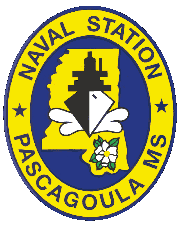
USS Estocin (FFG-15), ninth ship of the Oliver Hazard Perry class of guided-missile frigates, was named for Captain Michael John Estocin (1931–1967). Ordered from Bath Iron Works on 27 February 1976 as part of the FY76 program, Estocin was laid down on 2 April 1979, launched on 3 November 1979, and commissioned on 10 January 1981.

USS Oldendorf (DD-972), named for Admiral Jesse B. Oldendorf USN, was a Spruance-class destroyer built by the Ingalls Shipbuilding Division of Litton Industries at Pascagoula, Mississippi.

USS John Young (DD-973), named for Captain John Young, USN, was a Spruance-class destroyer of the United States Navy. The ship was built by the Ingalls Shipbuilding Division of Litton Industries at Pascagoula, Mississippi.

USS Merrill (DD-976), named for Rear Admiral Aaron Stanton Merrill USN (1890–1961), was a Spruance-class destroyer that entered service with the United States Navy in 1978. Merill served as the US Navy's test platform for the Tomahawk cruise missile. In the 1980s, the destroyer took part in Operation Earnest Will in the Persian Gulf during heightened tensions with Iran. The destroyer was decommissioned in 1998. The vessel was used as a target ship in 2003 and sunk off Hawaii in 2003.

USS Moosbrugger (DD-980) was a Spruance-class destroyer built for the United States Navy by the Ingalls Shipbuilding Division of Litton Industries at Pascagoula, Mississippi. Affectionately nicknamed the "Moose" by her crews, she was named in honor of Vice Admiral Frederick Moosbrugger who is best known for his service in World War II as a highly successful commander of destroyer squadrons.

USS Cushing (DD-985), named after Commander William Barker Cushing, was the fifth ship of the United States Navy to bear the name. Cushing was a Spruance-class destroyer built by the Ingalls Shipbuilding Division of Litton Industries at Pascagoula, Mississippi. Cushing operated out of Yokosuka, Japan for the last several years of her career. Cushing was the last Spruance-class destroyer to remain in active service, until decommissioned on 21 September 2005.

Naval Station Mayport is a major United States Navy base in Jacksonville, Florida. It contains a protected harbor that can accommodate aircraft carrier-size vessels, ship's intermediate maintenance activity (SIMA) and a military airfield with one asphalt paved runway (5/23) measuring 8,001 ft × 200 ft.
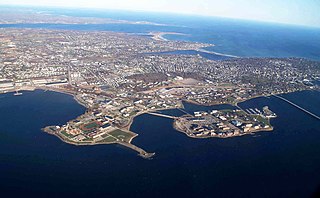
The Naval Station Newport is a United States Navy base located in the city of Newport and the town of Middletown, Rhode Island. Naval Station Newport is home to the Naval War College and the Naval Justice School. It once was the homeport for Cruiser Destroyer Force Atlantic (COMCRUDESLANT), which relocated to Naval Station Norfolk in the early 1970s. Newport now maintains inactive ships at its pier facilities, along with the United States Coast Guard. In BRAC 2005, NAVSTA Newport gained over five hundred billets, in addition to receiving, again, the Officer Candidate School (OCS), the Naval Supply Corps School, and several other activities, to include a few Army Reserve units.
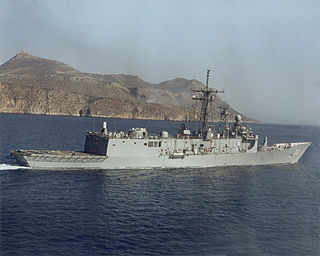
USS John L. Hall (FFG-32), twenty-sixth ship of the Oliver Hazard Perry class of guided-missile frigates, was named for Admiral John L. Hall, Jr. (1891–1978). Her mission is to provide in-depth protection for military and merchant shipping, amphibious task forces, and underway replenishment groups.

USS Crommelin (FFG-37), twenty-eighth ship of the Oliver Hazard Perry-class of guided-missile frigates, was named for five brothers: Rear Admiral John G. Crommelin (1902–1996), Vice Admiral Henry Crommelin (1904–1971), Commander Charles L. Crommelin (1909–1945), Lieutenant Commander Richard Crommelin (1917–1945), and Captain Quentin C. Crommelin (1919–1997). The Crommelin brothers were the only group of five siblings ever to graduate from the United States Naval Academy. Four of them became pilots, and Time magazine dubbed them "The Indestructibles." The brothers saw action in more than ten campaigns in the Pacific Theater. Henry, the oldest, became a Surface Warfare Officer while Richard and Charles died in combat as naval aviators in 1945. Individually and as a fighting family, they gained fame in World War II, attaining outstanding combat records and multiple decorations. Crommelin (FFG-37) is the first ship of that name in the United States Navy.
A destroyer squadron is a naval squadron or flotilla usually consisting of destroyers rather than other types of vessel. In some navies other vessels, such as frigates, may be included. In English the word "squadron" tends to be used for larger and "flotilla" for smaller vessels; both may be used for destroyer units. Similar formations are used in non-English-speaking countries, e.g., the "escadrille"—which would translate directly as "squadron"—in France.
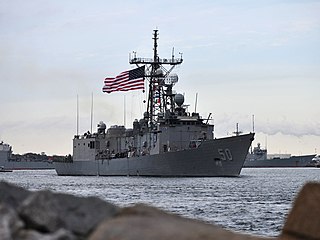
USS Taylor (FFG-50), an Oliver Hazard Perry-class frigate, was a ship of the United States Navy named for Commander Jesse J. Taylor (1925–1965), a naval aviator who was awarded the Navy Cross posthumously for his heroism in the Vietnam War.
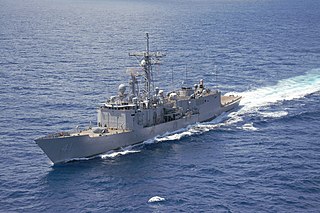
USS McClusky (FFG-41) was a Oliver Hazard Perry-class frigate of the United States Navy. She was named for Rear Admiral C. Wade McClusky (1902–1976) who as a lieutenant commander led the air group of USS Enterprise, which sank the Japanese carriers Kaga and Akagi during the Battle of Midway. McClusky later served as part of Destroyer Squadron 1, and after 31 years of service, was decommissioned on 14 January 2015 at Naval Base San Diego.

USS John Hancock (DD-981), a Spruance-class destroyer, was the second ship of that name, and the sixth ship of the United States Navy to be named for John Hancock (1737–1793), the President of the Continental Congress and first signer of the Declaration of Independence.

Naval Station Everett is a military installation located in the city of Everett, Washington, 25 miles (40 km) north of Seattle. The naval station, located on the city's waterfront on the northeastern end of Puget Sound, was designed as a homeport for a US Navy carrier strike group and opened in 1994. A separate Navy Support Complex is located in Smokey Point, 11 miles (18 km) north of Everett near Marysville, and houses a commissary, Navy Exchange, a college and other services.

Naval Station Rota, also known as NAVSTA Rota,, is a Spanish-American naval base commanded by a Spanish Rear Admiral. Located in Rota in the Province of Cádiz, NAVSTA Rota is the largest American military community in Spain, housing US Navy and US Marine Corps personnel. There are also small US Army and US Air Force contingents on the base.

Commander, Naval Surface Force, Atlantic (COMNAVSURFLANT) is a post within the United States Fleet Forces Command. As Naval Surface Force Atlantic, it is a military formation, but the organization is often known as SURFLANT. Its headquarters are at the Naval Station Norfolk, Norfolk, Virginia. The current commander is Rear Admiral Brendan R. McLane. COMNAVSURFLANT supervises all surface ships based on the Eastern United States and Gulf Coast of the United States, as well as ships forwarded deployed to Naval Station Rota, Spain.

Destroyer Squadron ONE, also known as Destroyer Squadron 1 and often abbreviated at DESRON ONE or DESRON 1, is a squadron of warships of the United States Navy. It is an operational component of Carrier Strike Group One and is administratively responsible to Commander, Naval Surface Forces Pacific.

Destroyer Squadron 7 is a naval unit of the United States Navy stationed in Singapore. It is assigned to the United States Seventh Fleet.

Destroyer Squadron 26 (DESRON-26) is a destroyer squadron of the United States Navy. It was first created in 1950. It has seen action in the Korean War, service in the Atlantic, in the Vietnam War. From 1974 for a period it became the 'Mod Squad', trialling ships commanded by officers one rank junior to the usual appointment rank.

